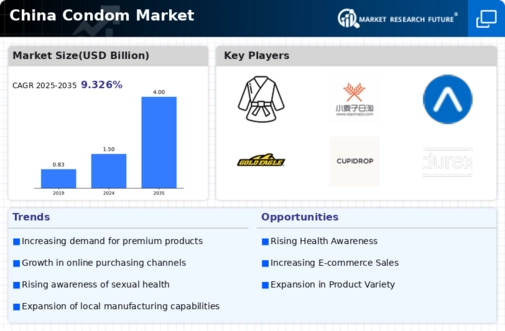Rising Disposable Income
The rise in disposable income among Chinese consumers is a significant driver for the condom market. As economic conditions improve, individuals are more willing to invest in personal health and wellness products, including condoms. This trend is particularly evident among the younger demographic, who prioritize quality and brand reputation when selecting sexual health products. In 2025, the average spending on condoms is projected to increase by 15%, indicating a shift towards premium products. The condom market is likely to benefit from this trend, as consumers seek out innovative and high-quality options. Additionally, the willingness to spend more on sexual health products may lead to increased brand loyalty, further solidifying the market's growth trajectory.
Influence of Urbanization
Urbanization in China is transforming lifestyles and social norms, which in turn influences the condom market. As more individuals migrate to urban areas, there is a noticeable shift in attitudes towards sexual health and contraceptive use. Urban populations tend to exhibit more liberal views on sexual behavior, leading to increased condom usage. The condom market is likely to see a surge in demand, particularly in metropolitan areas where access to sexual health products is more readily available. In 2025, urban centers are expected to account for over 60% of total condom sales, reflecting the changing dynamics of consumer behavior. This urban-centric growth may also encourage manufacturers to innovate and diversify their product offerings to cater to the evolving preferences of urban consumers.
Impact of Digital Marketing
Digital marketing strategies are reshaping the landscape of the condom market in China. With the proliferation of social media and online platforms, brands are increasingly leveraging digital channels to reach consumers. This shift allows for targeted marketing campaigns that resonate with specific demographics, particularly younger consumers who are more engaged online. In 2025, it is estimated that digital marketing will account for over 40% of total marketing expenditures in the condom market. This trend not only enhances brand visibility but also fosters a more open dialogue about sexual health, encouraging consumers to make informed choices. As brands adapt to the digital landscape, the potential for growth in the market becomes more pronounced, with innovative campaigns likely to drive sales.
Growing Awareness of Sexual Health
The increasing awareness of sexual health in China appears to be a pivotal driver for the condom market. Educational initiatives and campaigns by both governmental and non-governmental organizations have contributed to a heightened understanding of safe sex practices. This awareness is reflected in the rising demand for condoms, as consumers become more informed about sexually transmitted infections (STIs) and unintended pregnancies. In 2025, the market is projected to grow by approximately 8% annually, indicating a robust shift towards prioritizing sexual health. The condom market is likely to benefit from this trend, as consumers seek reliable protection and quality products. Furthermore, the integration of sexual health education into school curricula may further enhance the market's growth potential, as younger generations become more knowledgeable and responsible regarding their sexual health.
Government Policies and Regulations
Government policies and regulations play a crucial role in shaping the condom market in China. Initiatives aimed at promoting sexual health and responsible family planning have led to increased accessibility and availability of condoms. The government has implemented various programs to distribute condoms in public health facilities, which has contributed to a rise in usage rates. In 2025, it is anticipated that government-backed initiatives will lead to a 10% increase in condom distribution across the country. The condom market stands to gain from these policies, as they not only enhance public awareness but also encourage safe sexual practices. Furthermore, regulatory frameworks that support the production and sale of condoms may foster a more competitive market environment, ultimately benefiting consumers.





















Leave a Comment